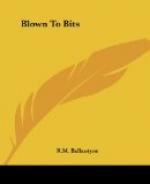“No man can be sure of that. If the last explosion emptied the crater there will be no more. If it did not, another explosion is certain. All I advise is that you should be ready for whatever is coming, and ready to take your only chance.”
“Right you are, sir. Send men to be ready to cut the cable, Mr. Moor. And stand by the topsail halyards.”
“Ay, ay, sir.”
During the anxious minutes that followed, the hermit rejoined Winnie and Nigel on the quarter-deck, and conversed with the latter in a low voice, while he drew the former to his side with his strong arm. Captain Roy himself grasped the wheel and the men stood at their various stations ready for action.
“Let no man act without orders, whatever happens,” said the captain in a deep powerful voice which was heard over the whole ship, for the lull that we have mentioned extended in some degree to the gale as well as to the volcano. Every one felt that some catastrophe was pending.
“Winnie, darling,” said the hermit tenderly, as he bent down to see the sweet face that had been restored to him. “I greatly fear that there is sure to be another explosion, and it may be His will that we shall perish, but comfort yourself with the certainty that no hair of your dear head can fall without His permission—and in any event He will not fail us.”
“I know it, father. I have no fear—at least, only a little!”
“Nigel,” said the hermit, “stick close to us if you can. It may be that, if anything should befall me, your strong arm may succour Winnie; mine has lost somewhat of its vigour,” he whispered.
“Trust me—nothing but death shall sunder us,” said the anxious youth in a burst of enthusiasm.
It seemed as if death were indeed to be the immediate portion of all on board the Sunshine, for a few minutes later there came a crash, followed by a spout of smoke, fire, steam, and molten lava, compared to which all that had gone before seemed insignificant!
The crash was indescribable! As we have said elsewhere, the sound of it was heard many hundreds of miles from the seat of the volcano, and its effects were seen and felt right round the world.
The numerous vents which had previously been noticed on Krakatoa must at that moment have been blown into one, and the original crater of the old volcano—said to have been about six miles in diameter—must have resumed its destructive work. All the eye-witnesses who were near the spot at the time, and sufficiently calm to take note of the terrific events of that morning, are agreed as to the splendour of the electrical phenomena displayed during this paroxysmal outburst. One who, at the time, was forty miles distant speaks of the great vapour-cloud looking “like an immense wall or blood-red curtain with edges of all shades of yellow, and bursts of forked lightning at times rushing like large serpents through the air.” Another says that “Krakatoa appeared to be alight with flickering flames rising behind a dense black cloud.” A third recorded that “the lightning struck the mainmast conductor five or six times,” and that “the mud-rain which covered the decks was phosphorescent, while the rigging presented the appearance of St. Elmo’s fire.”




